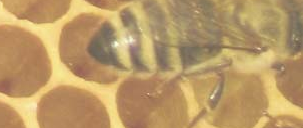
Selling Honey in Minnesota
Your honey sales MAY fall under the cottage food law in Minnesota, if you meet those requirements. But Minnesota's abbreviated rules for selling honey only apply to liquid and comb honey only, not processed honey, which has all the requirements of processed food. Honey (and also maple syrup as whole foods are considered a ‘product of the farm,’ and are already exempt from licensing under Minnesota's food law, M.S. 28A.15. UNLESS you add flavorings; in that case they would be a cottage food.
If an individual buys honey from a honey producers with the intent to resell that honey, they would no longer be considered a ‘product of the farm’ or a ‘cottage food’ and that individual would then be required to get a license from the MDA to resell. Aside from this, the requirements specific to honey are pretty much all about the labeling.
So after checking the honey labeling below, go to this page for details about selling cottage foods in Minnesota.
Labeling
The principal display
panel must be large enough to clearly accommodate all required label
information without crowding or obscuring designs. All information
on the label must be prominent and conspicuous, but in no case may
the letters and numbers be less than 1/16 inch high.
Product
identity must be on the label, i.e., honey. A complete list of
ingredients, if other than honey, including standardized food
products, must be on the label in order of predominance by weight if
there are two or more ingredients. All artificial colors must be
specifically listed. Include your name, and address (including zip
code) on the label.
The net quantity of contents must be
expressed in terms of weight or measure. This declaration of
contents must be expressed both in ounces and full unit if one to
four pounds, or one pint to one gallon. The metric equivalent is
sometimes required. The declaration must be located in the lower
one-third of the label separated from all other print. If the weight
is more than one pound, fractions of a pound are expressed as a
decimal, e.g., 1 1/2 pounds is 1.5 lb. The declaration must be in
letters and numbers in a type and size relative to the area of the
label panel of the package as follows:
Not less than 1/16
inch in height for a label of five square inches or less.
Not
less that 1/8 inch in height for a label of more than five square
inches but less than 25 square inches.
Not less than 3/16 inch in
height for a label more than 25 square inches.
To convert ounces
to grams multiply by 28.4 and round off to grams. To convert pounds
to grams multiply by 454.
Don't make health claims on a food
label. Health claims are subject to special nutritional labeling.
All labeling must be truthful and accurate. Food standards must
not be violated.
The US Grade is voluntary on honey labels,
offered as a fee for service by the U.S. Department of Agriculture's
Agricultural Marketing Service. Grade is primarily moisture and
color; Grade A = 18.6 percent moisture and freedom from defects (no
foreign material) if filtered. If a Grade is used, the Grade must be
accurate and must declare the country of origin.
Many
products have exemptions or further requirements to the above label
regulations.
Resources
Minnesota resources
General
Great helpful books and guides
The Backyard Beekeeper - Absolute Beginner's Guide to Keeping Bees in Your Yard and Garden, Setting up and caring for your own colonies,practical and nontoxic ways to care for your bees, Swarm control
The Backyard Beekeeper's Honey Handbook: A Guide to Creating, Harvesting, and Cooking with Natural Honeys
Beekeeping For Dummies, very popular
The Backyard Beekeeper’s Honey Handbook by Kim Flottum